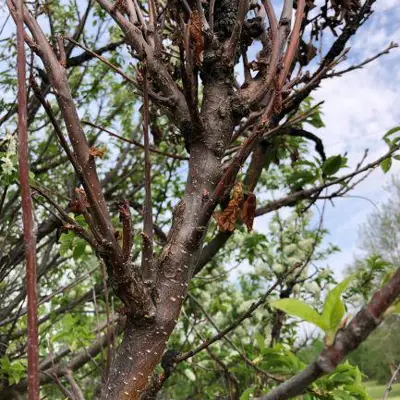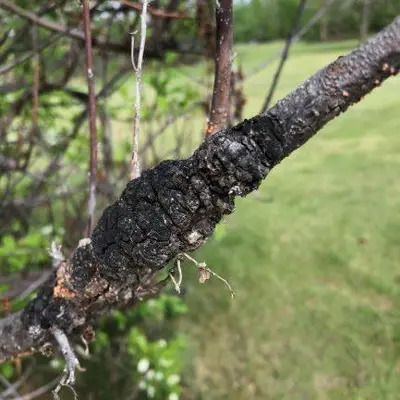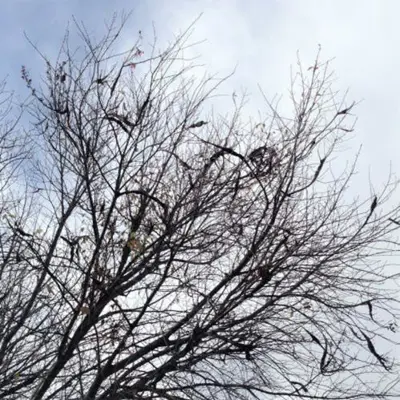Black Knot - Avoid Mistakes
Black Knot (Dibotryon morbosum) is a prevalent disease in the Canadian prairies, naturally occurring and predominantly affecting trees and shrubs within the Cherry (Prunus) genus. Various species, including ornamental and edible cherries, such as Maydays, Shubert chokecherry, chokecherry, Nanking cherry, pin cherry, sand cherry, sour cherry, Saskatoon's, and plums are susceptible to this disease.
While black knot may significantly reduce crop yield in fruit production, for individual trees it usually takes years, and sometimes even decades, to fully destroy the mature tree. Unlike rapid and deadly diseases that can swiftly kill a tree within a year or two, with proper management black knot spread and the eventual demise of the affected trees and shrubs is preventable.
Improper pruning and the timing of pruning are major contributors to the spread of black knot. Avoiding pruning mistakes and selecting the right time for this activity is crucial in preventing the disease from spreading.
Identification and Symptoms
Recognizing black knot is relatively straightforward, particularly during fall and winter when infestation is most apparent. Dark, black-colored swelling galls, resembling tumor growth, on branches or stems become noticeable, even from a distance, on affected trees. In early summer, newly developed infections exhibit velvety green/olive color swellings along branches or twigs. The maturation of black knot, including the colour, may take up to four years. During winter, spores mature and a single average-sized (2-4 inch) black knot can release millions of tiny spores. Spores are dispersed in spring, during wet periods and, without control, they naturally spread.
Mature black knots typically measure between 2-4 inches, though infestations as large as10 inches long on bigger branches are not uncommon. Deformed twigs and branches are frequent indicators of the disease. Galls encircle and strangle branches, ultimately causing their death. Older black knots may be partially covered with a white-pinkish fungal mould or perforated by insect-made holes. Wood decay fungus may infiltrate the trunk or branches afflicted by black knot.
Originally published on March 27, 2024
Management of Black Knot
Management of black knot involves addressing the natural spread of spores by wind and rain, acknowledging that little can be done to control these factors. Unfortunately, one prevalent means of disease transmission is through improper pruning during the growing season. The key action to take is to monitor trees and shrubs for potential infestation, with a focus on timely and proper pruning to minimize or eliminate risks. Opting for tree and shrub species resistant to black knot is also a viable strategy, as chemical control methods are not effective against this disease.
Effective Pruning Timing for Black Knot Control
- Pruning should only be conducted during winter, when temperatures are well below 0 Celsius, rendering spores inactive and unable to survive exposure to the cold winter climate. At this time, trees and shrubs are dormant, ensuring that they will not be harmed by pruning cuts.
- Avoid pruning in late fall (September, October, and November) or early spring (March, April, and May), as both periods pose potential risks to trees and shrubs. Pruning in late fall can damage cuts, as trees may not have completely shut down for winter. In early spring, it may be challenging to determine if spores are active and if sap is already flowing within trees and shrubs.
- Refrain from pruning during the growing season unless there is a first-time observation of new infestation. Pruning during this period is a high-risk activity that can contribute to the spread of the disease.
- Avoid pruning on wet, rainy, and windy days, as spores are easily dispersed under these weather conditions.
Guidelines for Proper Pruning and Removal
- Begin by acquiring basic knowledge about proper pruning, emphasizing safety precautions.
- Ensure the availability of suitable and sharp tools for the pruning of trees and shrubs.
- Recognize that the fungus spreads within the wood well below the infested area. Consequently, it is essential to prune at least 12 inches, or ideally 24 inches, below the affected region.
- If pruning a few infested branches during the growing season, disinfect pruning tools after each cut. In winter, disinfect tools both before and after pruning.
- Pruning all the way to the collar of a branch is sometimes recommended for effective removal.
- In the case of heavily infested trees and shrubs, complete removal is the most effective method to mitigate the impact of black knot.
- Immediately remove infested wood. The proper disposal of infested branches is as crucial as the pruning process itself, as spores can be dispersed even up to four months after pruning. Avoid leaving branches near other trees or shrubs.
- For a small number of branches, place them in a garbage bag, while bigger tree material should be disposed of in a landfill. During winter, burning infested wood is a viable option.
Contact Us
Saddle Hills
Junction of Hwy 49 & Secondary Hwy 725
RR1, Spirit River AB
T0H 3G0
T. 780-864-3760
Fax 780-864-3904
Toll-free 1-888-864-3760
frontdesk@saddlehills.ab.ca
Sign up to our Newsletter
Stay up to date on the Saddle Hills activities, events, programs and operations by subscribing to our eNewsletters.



